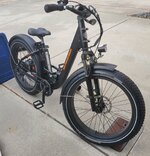uberbike
New Member
- Region
- USA
I am helping a friend with his Rad Power bike and Bolton controller upgrade. After install if I go up a significant hill with full 1500w of power for like 2-3 minutes the bike cuts out. Screen goes blank and bike stops. When I check the power meter on the battery it won't respond with any lights. If I unseat the battery and re-seat the battery indicates full and the bike will work again.
I tried this on two identical fully charged batteries and I get the same symptom.
Is it possible this stock battery just can't handle being asked to put out twice the power as stock and the BMS is cutting out?
I tried the same hill, same battery, same controller but pedaled more and was easier on the throttle and it made it ok.
I don't know model number of bike but attached are pics of the bike and battery.
Thanks in Advance!
I tried this on two identical fully charged batteries and I get the same symptom.
Is it possible this stock battery just can't handle being asked to put out twice the power as stock and the BMS is cutting out?
I tried the same hill, same battery, same controller but pedaled more and was easier on the throttle and it made it ok.
I don't know model number of bike but attached are pics of the bike and battery.
Thanks in Advance!

